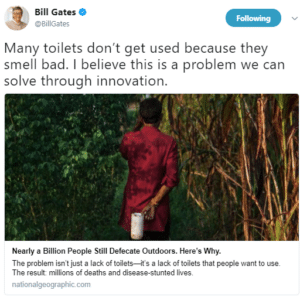On August 2nd, the world’s richest man, Bill Gates, tweeted that, “Many toilets don’t get used because they smell bad. I believe this is a problem we can solve through innovation.” He couldn’t be more correct. About a year ago, I wrote a blogpost titled, “Stop building schools; stop building water wells; and stop building toilets,” to illustrate the point that most of these resource-intensive development projects are rarely successful. They are expensive, unsustainable, and unscalable. And most of all, many of the beneficiaries for which they are built hardly make use of them for long because they are not designed to address the concerns of the beneficiaries. Toilets are perhaps the biggest culprits.
Even though India’s government is aggressively working to build 60 million toilets by 2019, the government is finding out that many of those toilets are going unused. In fact, approximately half a billion people in India still open defecate. This is such an intractable problem that the government is considering paying people to use toilets. Instead of doing that, however, the Indian government should heed the words of the world’s richest man. They should encourage innovation.
Innovation is simply the process by which we create practical solutions to actual problems. As it turns out, many of the solutions being developed to help the poor—be it in fixing education, developing infrastructure, or, in this case, solving the widespread sanitation issue—are neither practical, nor do they solve the actual problems the poor are facing. A solution is practical if the people for which it is designed can afford it and can easily integrate it into their lives. Unfortunately, when crafting solutions many experts misdiagnose the problem, resulting in solutions that aren’t designed to address the concerns of the beneficiaries. For example, a development program in Lesotho designed to help locals improve their crop and livestock management failed because few people in the region were farmers and conditions in the region were not suitable for farming.
Innovation for toilets?
So, where should we begin if we decided to develop an innovation for toilets? First, we must think about the competition—open defecation, or what we call nonconsumption of toilets. In this circumstance, as in many circumstances in the business world, we must think about why people do not use toilets, and more specifically why so many still use the competition, even when they have access to our product. It is only when we understand this that we will be able to develop an innovation that people can pull into their lives. Three things come to mind when we consider why people choose to defecate in the open.
First, open defecation is free, in contrast with a majority of toilets in poor communities. If I am a poor person living in a poor country, it is fairly easy, and free, to find an open space to ease myself. This is very important, because the one resource that people living in poverty lack the most is money, and the prospect of paying for the chance to use the bathroom, when there is a free and easy-to-use option is typically a non-starter. The value that people receive from a new innovation must outweigh the freeness of the existing solution the competition offers. In other words, the innovation must be so much better than open defecation, that people will be willing to pay something for it. Unfortunately, most solutions are not. In fact they are worse, and this brings us to the second point.
Second, open defecation is not smelly. Most innovations that try to tackle this problem, such as latrines and public toilet port a potty solutions, are smelly, which means they instantly provide less value than defecating in the open. Consider this, would you be willing and excited to use a very smelly toilet that you had to pay for when a viable solution, which you have been using all your life, exists? Even for the rich who have access to modern day plumbing, how many of us use public restrooms, or are thrilled about the prospect of using smelly toilets? No one appreciates smelly, and seemingly unhygienic toilets, regardless of whether the person is poor or not. And until we understand this, we will continue to develop solutions that are not viable.
Third, open defecation is currently seen as “natural and normal,” even when it comes with severe consequences, such as sickness and the danger of being attacked. This is how strong the competition is—young women have been known to get raped simply for going out at night to ease themselves, but continue to use it because it is currently the most viable option they have.
When we consider the benefits of open defecation, this problem might seem unsolvable. But if we fundamentally change the way we think about the problem, then perhaps we can make progress.
For instance, instead of enumerating all the problems with open defecation—and there are many—what if we considered the benefits as described above? And then what if we developed an innovation, hard as it may be, to replicate those benefits? What if, instead of spending billions of dollars on building toilets in poor communities, many of which will go unused, we spent a fraction of those funds on research and development for a new class of toilets—simple, affordable, and non-smelly. What if more organizations did what the Gates Foundation is doing with its Reinvent the Toilet Challenge?
I don’t know what the answer is to this problem. No one does. That, however, has not stopped us in the past. When faced with seemingly intractable problems, from the eradication of deadly diseases to putting a man on the moon, we have developed innovations that have helped us solve these challenges. We can do the same here.
But more broadly in the development community, what might happen if we used this kind of “practical solution to actual problems” thinking to address other development challenges, like corruption, lack of infrastructure, bad institutions, and poor education? For example, what if, instead of only decrying corruption, we tried to understand it. And then fix it. If we did, we would not only see the end of poverty as we know it, but also the beginnings of prosperity for billions of people in our world.




